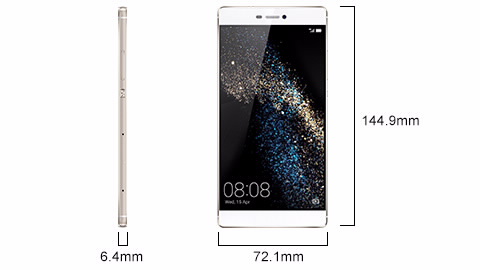Claudio Costerni ⢠8 months ago
Gannon,Â
a decrease by 78% of the COLOR NOISE, not the brightness!

| 19-12-2015 (3848 ) | Categoria: Telecom |
posted Wednesday, April 15, 2015 at 4:08 PM EST

Â
Today, Chinese smartphone manufacturer Huawei announced theHuawei P8, its latest flagship phone. In presenting the new smartphone Huawei laid out the groundwork of the camera within it, claiming it features âthe worldâs first 13-megapixel four-color RGBW sensor.â
This new sensor is said to increase brightness in images by 32% in high-contrast situations and decrease color noise by 78% in low-light. But what this means is you will see brighter whites and deeper blacks in the resulting images.

To make better use of the data from sensor, a new âDSLR-levelâ dedicated image processor is included in the phone. Itâs said to reduce noise, particularly in low-light, and optimize results in high-contrast scenes.

In addition to the improved sensor and processor, the P8 features an optical image stabilization system that is said to compensate for vibrations twice as much as the iPhone 6 Plusâs, with 1.2-degrees of compensation over the iPhone 6 Plusâs 0.6-degrees.

Huawei smartphones arenât exactly huge sellers outside of the Chinese market, but the technology is impressive in a smartphone and will likely be replicated by other manufacturers. Itâs also worth noting Huawei isnât the first to develop an RGBW sensor. Sony has had one in development since 2012. According to Ars Technica, it appears as though this is the Sony sensor previously mentioned, not a Huawei sensor.
(via Image Sensors World)
 |
|
|
Mystic Champagne/Titanium Grey |
|
|
Hisilicon Kirin 930, 8-core 64bit, 2.0GHz |
|
|
Android⢠5.0 |
|
|
RAM : 3 GB;Â |
|
|
GRA_L09: GRA_UL00: |
|
|
GPS/A-GPS/Glonass/BDS(BeiDou Navigation Satellite System) |
|
|
Wi-Fi 2.4GHz b/g/n with Wi-Fi Direct support |
|
|
G-Sensor, Gyroscope sensor, Ambient Light Sensor, Proximity sensor, Compass, Accelerometer |
|
|
13 Mega pixel main Camera, OIS, RBGW sensor, DSLR-level Image Signal Processor, 1080p video recording/1080p video playback; F2.0; Dual color temperature flash |
|
|
Audio: MP3ăMIDIăAMR-NBăAMR-WBăAACăAAC+ăeAAC+ăPCMăWMA |
|
|
Video Codec: MPEG-4, H.264, H.263, VP8, RV7-10, Xvid, WMV9 |
|
|
EMUI 3.1 |
|
|
2680mAh(Typical Value) |
|
|
HandsetĂ1 |
They are claiming the world's first 13MP RGBW. With that 13MP qualifier, they are correct.
ReplyTheir PR official PR, linked and quoted in the post, does not mention 13MP. They only state "the world's first four-color RGBW sensor." The 32% and 78% explanation part is too messed in the PR, but appear correctly in the slides.
Of course, it is not the first 13MP RGBW sensor. And Samsung in 2013, and Sony later do it. But as i think they refused of it. As I think, really RGBW sensor have not benefits.
Yes, this sensor can get more light. But you CAN NOT receive from this extra light the color information.Â
I really think of it :) And it is impossible in my opinion)
May be the PR means it is using the FIRST 13MP RGBW sensor Samsung used in 2013? :-)
I think this RGBW sensor would be useful especially in low light combined with super resolution processing algorythms, such as Almalence's BetterCamera SUPER mode. (Incidentally Omnivision has a collaboration agreement with Almalence)Â
Yet we don´t know which sensor this is, it would be interesting if it was a large pixel sensor such as OV13860 1.3um pixels, but I doubt it, pixel size isn´t mentionned so probably it is the habitual 1.1um
whose sensor is this?
ReplyIt is SONY IMX278.
http://news.91.com/android/1504/21818568.html
"For a very good image stabilizer one needs to have about 2-2.5deg range" Why?
ReplyIn such small camera modules does not apply the principle of the DSLR. Even slight hand movement can destroy and optical image stabilization and digital. This movement is about 0.5 centimeters
I agree that 150 gram handheld devices are more sensitive to high frequency shaking then a 500 gram handheld device, especially those with three natural points of support (two hands and a chin/eye). Shake reduction in phones should be better in terms of degrees then shake reduction in dslrs.
It's not just the three points of support. 2 degrees in the DSLR is equivalent to the motion of the camera such as a centimeter, for example. 2 degrees in the smartphone (according to the size of the matrix and optics) is equivalent to the motion of less than 1 millimeter:)
The images of the horse are generated from one image,
ReplyPhotoshop probably...unless they tied down the horse or waited for the exact event to happens twice, the probablity of the latter being one in a trillion trillion trillion.....
This is a poster. The text underneath says it's shot under 5 lux. Certainly not a sunny day.
Didn't Kodak publish on RGBW patterns back in 2009 and even earlier? 2007?
ReplyRGBW goes back (at least) to US 2,755,334 by Banning, filed in 1951, and referenced by Bayer as prior art.
How would the white pixel impact dynamic range in a bright scene? There is mention of high contrast but only low light images are shown? Would white pixel saturate faster than green and cause lower dynamic range overall compared to RGB sensor?
ReplyThe white pixel will saturate faster but pick up more light in the shadows, improving shadows. RGB will keep highlights almost as good as usual because they don't saturate that fast.
Actually i would prefer an array where some of the pixels are white and some are dimmed by darker filters. Maby a 8 filter pattern rather then 4 filter (RGGB or RGBW) pattern. That will improve highlights at the cost of noise. Maby another pattern having more sparely spread darker pixels. Sensors operating close to or beyond the diffraction limit and optical limit may improve dynamic range this way without sacrificing much in terms of resolution and noise.